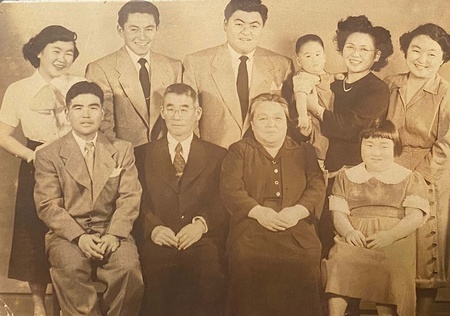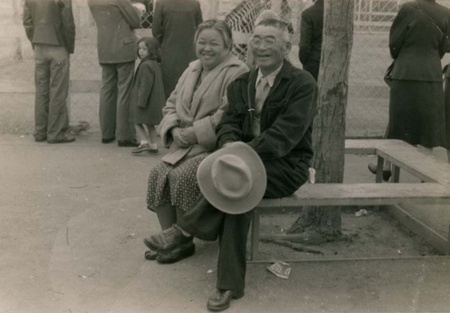In my childhood home in Roseville, California, we had a room we called “the den.” It was not the formal living room, where we had two couches, a fireplace, and a glass-topped coffee table. “The den” was a place for watching TV and listening to records from my dad’s impressive record collection; he’d had a tansu built specifically for that collection, with record-size compartments painted black inside and room for speakers at each end. Every day, I would pass by a framed oval portrait of my Issei grandparents that hung on a wall in the den. Now that I think about it, the portrait hung in the center of what was really the central room of our house.
The portrait is not so terribly different from other formal portraits of immigrant ancestors that I’ve come to see—black and white, a view of my grandfather and grandmother from the chest up. No fancy background or accessories behind them, just a nondescript backdrop. Two people in Western clothing: my grandfather is wearing wire-rimmed glasses,a dark suit and tie, and a white shirt; my grandmother is in a dark serviceable dress, no lace or frills, four plain round white buttons coursing down her V-neckline. They are both dressed so soberly you might guess they’re dressed for a funeral. Neither of them is smiling; their mouths form the same straight lines. My grandfather’s hair is cropped short; his hairline is receding back from his eyebrows, my grandmother’s hair is streaked with gray.
Grandpa Nimura died in 1960, long before I was born. Though there are pictures of baby me on Grandma Nimura’s lap, she died when I was three years old—I was not old enough to remember her. For most of my life, they lived in my imagination through the filter of this formal portrait—dour, unsmiling. They feel too distant, too sepia, and because of this I can’t call them anything but “Grandpa” and “Grandma,” nothing as affectionate as “Jiichan” and “Baachan.”
As I got older, I began to acquire other family pictures, partly from my dad’s other siblings, my aunties and uncle, and partly from my mother as she sorts through family archives. This is how I got the second photo of my grandparents. This photo shows my grandparents again, this time surrounded by their six children and their new son-in-law and first grandchild, my eldest cousin.
When I look at this picture I’m drawn of course, first, to my dad, a young man in perhaps his early twenties, standing in the back row at center. He and my uncle are both wearing suits and white shirts; my uncle is a young Japanese Frank Sinatra, dapper. Then my eyes move to the faces of my aunts and uncles, these familiar faces I grew up with, so many of them smiling. There’s my oldest cousin, a toddler in arms—one of the main ways I know that this picture was taken after the war. Nothing marks the passage of time like children.
One of my aunts is wearing a short sleeve white blouse with a jaunty scarf tied around her neck; my oldest auntie has her hair in a pompadour style and pearls around her neck; another auntie has a long dress with a long skirt and (fun) buttons cascading down the side of the skirt. Seated next to my grandmother, my youngest auntie is still a child, in a dress with eyelet lace at collar and cuffs. She was born in camp.
Then my eyes move to the couple seated front and center. My grandparents, Junichi and Shizuko. He was probably 67 years old in this picture. My grandmother was some 16 years younger, but she looks just as old, if not older. The two of them seem to wear camp like none of their children. They are in their sixties and early fifties, but they look like they are in their eighties.
With the exception of my cousin and my oldest uncle, everyone in this picture was incarcerated during the war.
It’s a striking contrast between the parents and children. So much energy in the siblings. You can practically hear my oldest auntie’s laugh, the one that used to ring out across our local supermarket. So little energy in my grandparents’ faces, as if they were posing to be statues. Impassive.
The contrast between the two generations feels so clear to me here. The bodies of my grandparents all wearing migration, camp, the Depression, six children living, two dying in infancy before those. My grandparents’ faces are so familiar, but only from this picture.
Only years later does my husband Josh discover that this picture of my grandparents and the picture of them with their family are actually from the same sitting, if perhaps not the same shot. That is, the photographer seems to have created one picture of my grandparents, air brushed out the children around them for one formal portrait, then created another portrait of the full family.
And still years later, I find another picture of my grandparents from my oldest auntie’s photo album. This time they are both smiling and relaxed, sitting outdoors. This one photo alone causes my idea of them to change—I now see where my dad, aunts, uncle got their smiles, their radiance. It was naive of me, of course, to think that my grandparents were always dour and unsmiling, but the circumstances under which they had those photographs taken must have been so different.
The layers keep peeling back, as with so much camp history.
What does it say that my grandparents were still and unsmiling, posing as so many immigrants did, formally, before the war, while my dad and his siblings seem more relaxed, natural, smiling, even buoyant?
What does it mean that the photographer air brushed the children to create the picture of just my grandparents?
What does it mean that this was the main image I had of my grandparents growing up? They were truly frozen in time in this picture for me that I saw every day in the den.
I think about Dorothea Lange, her now-iconic pictures that she took of Japanese Americans being rounded up, evicted, imprisoned. I never knew until 2021 that she, too, faced constraints on her photos—that the military did not allow her to document the guns, the guards, the bayonets, the barbed wire fences— any sign of resistance. Because she preferred outdoor lighting for her subjects, and the women remained indoors, many of her photographs in camp were of men. So I have to think about the gaze of the photographer. My childhood images of my grandparents—all of these had specific, unseen restrictions. Prohibitions. The images, like my images and ideas of camp, can also be unfolding, shifting. What felt like terra firms for so long can actually be more like earthquake country. Aftershocks that unsettle, even dormant volcanoes of memory that can erupt.
I think about all the pictures that my family and other Japanese American families had to burn before they left for camp.
For those of us who have been born from (or into) camp history, those of us who are direct descendants and survivors, ideas about our families in camp may have hardened or calcified inadvertently into ideas or images that are partial, incomplete without framing. A knowledge base that should be investigated, examined—or that can shift when given the chance. The image that I had in my head of my grandparents—dour, unsmiling—was only one image of them. Other pictures of them can round out their lives and expand my ideas of who they were.
Camp history for me has been like my journey with these two photographs. I will think that I can or should accept an image and hold it in my head as accurate, crystallized. Two immigrant grandparents, impassive. But then other factors, aspects, photos will come to light. I see the children around the parents, I look at the contrast and the tension between the two groups. I think about the brush the photographer used to erase the children around the parents. I think about the decades that passed where I did not make the connection between the two photos. I rewind and replay the development with the photos, over and over, and I think about the mechanisms of visibility and erasure. Each phase of my knowledge about these photos is a new chapter in my family story, of camp history.
I think about other descendants, too. Each of us have ideas, images frozen in our heads of what camp was, where our families’ supposed loyalties were. But we can allow new developments in the unfolding of camp history to come to light. We can allow these to inform and infuse our knowledge and understanding of what came before, or what we thought came before, and allow these to transform into what is yet to be.
This is perhaps why camp history, the larger project of camp history itself, keeps drawing me back—as deep as the layers around camp, that are as just as deep as each layer of sedimented knowledge and story. The silence may feel as deep as the story, but the story is even deeper than the silence.
It means that excavation is a careful, deliberate process.
It means that excavation, that genealogy work is an act of love and reckoning.
© 2022 Tamiko Nimura








